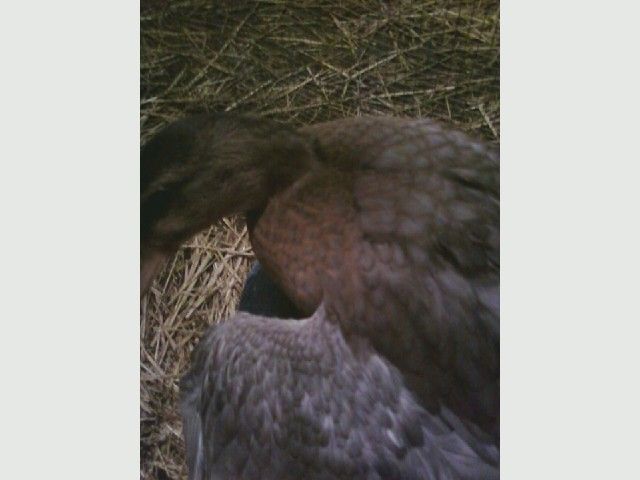- Mar 21, 2009
- 2,229
- 52
- 349
So, I thought I would share a really pretty new color variety I have started and see if there is any interest in it. I am not sure whether or not to continue with it, but I think the birds are turning out really pretty and the back story of the birds is interesting...
We have been working with a couple different varieties of Mallard mutations. I am working with a hatchery that sent me several Mallard "sports" last year that they wanted me to work with. The birds hatch in about 1 in 5,000 ducklings. As ducklings, they are much darker than normal Mallards. Looking down, they almost appear to be Black as the dorsal spots are entirely obscured. On the face, they have two very thick black stripes that cover almost the entire face (some of them almost look like Black Bibbed as ducklings). Anyway, they sent me 7 of these birds last year. I kept the darkest 3 birds, all of which ended up being hens. In the adult plumage, they look very similar to normal Mallards. They are just much darker than normal, but otherwise look like Mallards (still with Mallard feather pattern, they did not end up feathering out black).
We have had a few thoughts on what mutation they may be, but really need to do some breeding tests and we don't have a male in this color so I will have to breed to normal Mallard if none in this variety hatch this year. So, we also have an old Pastel Mallard drake that was not paired this year. We were consolidating cages and put these hens in with him. He immediately bred them and fertile eggs soon followed. I decided to hatch a few just to see what would result and this is what we got....


Sorry for the low quality pics! I took this out in the barn at night with my cell phone! LOL. Anyway, I was pretty much expecting Blue Fawn which is what they most closely resemble. They are overall darker than most Blue Fawns (again, somewhat to be expected since the hens are very dark). They are a much more lilac shade though then Blue Fawns with the brown areas having a definitive pink cast to them (hard to see in pics). The wings are a solid lilac color (not genetically, just in visual appearance). I have seen that to some extent in Blue Fawns. These are just more pronounced.
Anyway, I can't decide whether or not to hatch more, but they are still laying. It could be an interesting project while I am awaiting mates for the parent birds. It is one of those sort of projects that I would have very little opportunity to recreate as the hens are sports and the drake is also a rare variety (and has had fertility issues). The next generation could be really interesting as I imagine I would end up with some very darkly colored Pastels (25% from the double Blue dilution) with similar lilac tones. Thoughts?
We have been working with a couple different varieties of Mallard mutations. I am working with a hatchery that sent me several Mallard "sports" last year that they wanted me to work with. The birds hatch in about 1 in 5,000 ducklings. As ducklings, they are much darker than normal Mallards. Looking down, they almost appear to be Black as the dorsal spots are entirely obscured. On the face, they have two very thick black stripes that cover almost the entire face (some of them almost look like Black Bibbed as ducklings). Anyway, they sent me 7 of these birds last year. I kept the darkest 3 birds, all of which ended up being hens. In the adult plumage, they look very similar to normal Mallards. They are just much darker than normal, but otherwise look like Mallards (still with Mallard feather pattern, they did not end up feathering out black).
We have had a few thoughts on what mutation they may be, but really need to do some breeding tests and we don't have a male in this color so I will have to breed to normal Mallard if none in this variety hatch this year. So, we also have an old Pastel Mallard drake that was not paired this year. We were consolidating cages and put these hens in with him. He immediately bred them and fertile eggs soon followed. I decided to hatch a few just to see what would result and this is what we got....


Sorry for the low quality pics! I took this out in the barn at night with my cell phone! LOL. Anyway, I was pretty much expecting Blue Fawn which is what they most closely resemble. They are overall darker than most Blue Fawns (again, somewhat to be expected since the hens are very dark). They are a much more lilac shade though then Blue Fawns with the brown areas having a definitive pink cast to them (hard to see in pics). The wings are a solid lilac color (not genetically, just in visual appearance). I have seen that to some extent in Blue Fawns. These are just more pronounced.
Anyway, I can't decide whether or not to hatch more, but they are still laying. It could be an interesting project while I am awaiting mates for the parent birds. It is one of those sort of projects that I would have very little opportunity to recreate as the hens are sports and the drake is also a rare variety (and has had fertility issues). The next generation could be really interesting as I imagine I would end up with some very darkly colored Pastels (25% from the double Blue dilution) with similar lilac tones. Thoughts?
Last edited:




